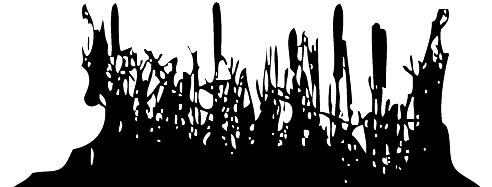Français
Finding Our Talk Season One
- Episode 1: Language Among the Skywalkers: Mohawk
- Episode 2: Language Immersion: Cree
- Episode 3: The Trees are Talking: Algonquin
- Episode 4: The Power of Words: Inuktitut
- Episode 5: Words Travel On Air: Attikamekw/Innu
- Episode 6: Language in the City: Ojibway/Anishinabe
- Episode 7: Getting Into Michif: Michif
- Episode 8 : Plains Talk: Saulteaux
- Episode 9: Breaking New Ground: Mi'kmaw
- Episode 10: A Silent Language: Huron/Wendat
- Episode 11: The Power of One: Innu
- Episode 12: Syllabics: Capturing Language: Cree
- Episode 13: A Remarkable Legacy: Saanich
Finding Our Talk Season Two
Finding Our Talk Season Three
Episode 4: The Power of Words - Inuktitut
Complementary sides of the language and education equation in Nunavik are the subject of this episode. At a language conference in Puvirnituq, we witness efforts to keep Inuktitut alive and up-to-date, largely through the knowledge and commitment of elders. At the local school, we look in on efforts to keep the language current among the new generation of speakers, the children who, in effect, hold the future of the language in their hands
Background
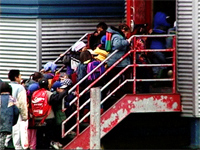 The language of Nunavik, Inuktitut, is part of the Eskimo-Aleutian family of Aboriginal languages, which extends from Siberia, through Alaska and the Canadian Arctic, to Greenland. Of all Aboriginal languages in Canada, Inuktitut is the most viable and boasts the largest percentage of speakers. Almost the entire population of 6,000 Inuit in Nunavik speaks their native language fluently.
The language of Nunavik, Inuktitut, is part of the Eskimo-Aleutian family of Aboriginal languages, which extends from Siberia, through Alaska and the Canadian Arctic, to Greenland. Of all Aboriginal languages in Canada, Inuktitut is the most viable and boasts the largest percentage of speakers. Almost the entire population of 6,000 Inuit in Nunavik speaks their native language fluently.
Inuktituk language policy in Nunavik had its origin in a 1984 meeting of the Inuit Language Commission, whose proceedings served as the basis for developing language guidelines. The Commission's mandate came from Inuit Elders who felt that a body should be established to oversee and ensure the preservation of the Inuktitut language and writing system. Its overarching aim was to ensure that children of coming generations continue to speak Inuktitut.
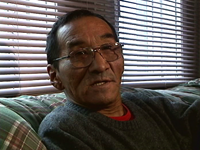 The specific mandate of the Language Commission included standardization of the writing system, development of Inuktitut words for English words without translation and decisions regarding symbols to be used on typewriters. It would oversee and approve all Inuktitut language productions, such as dictionaries, reference works and school books.
The specific mandate of the Language Commission included standardization of the writing system, development of Inuktitut words for English words without translation and decisions regarding symbols to be used on typewriters. It would oversee and approve all Inuktitut language productions, such as dictionaries, reference works and school books.
Additional aims of the Commission were to promote recognition of Inuktitut as the official language of the Inuit and to find an Inuktitut name for Northern Québec, which ultimately became Nunavik.
In 1989, the "terminology project" was inaugurated, its aim to bring the language up-to-date with the addition of words for terms and concepts that did not previously exist - medical and legal terms, fruits and vegetables, etc. Avataq Cultural Institute compiled this random list of words into a database and in 1995, it was published. Over 3,000 words have been collected so far.
Part 1
The main purpose of the language conference is to bring together translators, interpreters, language specialists and elders to develop and integrate new words into the Inuktitut lexicon. At workshops, participants develop new words based on a pre-agreed set of themes and other sessions are allocated to special requests and the submission of new words.
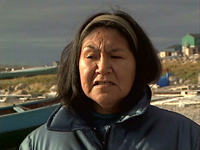 In this segment, we see the work of the conference as a whole, getting a sense of its dynamic nature and of the range of participants. We feature individual participants who play central roles in the process of renewing and preserving the Inuktitut language. Robbie Watt, then President of Avataq Cultural Institute, shares his views on the role of the conference and its importance in bolstering Inuit identity and culture.
In this segment, we see the work of the conference as a whole, getting a sense of its dynamic nature and of the range of participants. We feature individual participants who play central roles in the process of renewing and preserving the Inuktitut language. Robbie Watt, then President of Avataq Cultural Institute, shares his views on the role of the conference and its importance in bolstering Inuit identity and culture.
Rapid change in the way of life in Northern communities, brought about by the introduction of many of the trappings of modernity, including television, computers, pop music, cars and southern foods, make it imperative not only to change the language to accommodate these new concepts and objects but also to find a way of preserving the words that were meaningful in the way of life that existed in the past. During the conference, we focus on the important role of the elders, whose knowledge of the language is key to preserving it for future generations.
A key person in this regard is Davidie Niviaxie, first Chairman of the 1984 Inuit Language Commission. Davidie has worked tirelessly for the past 20 years, collecting and translating words in danger of being lost because of changing lifestyles.
 Part 2
Part 2
When the Inuit of Northern Québec negotiated the James Bay Northern Québec Agreement with the provincial government in 1975, they received, in exchange for ceding some land rights, control over the social, political and economic tools with which to manage their own affairs. On that basis, the Kativik School Board was created, to manage the education of Inuit children in community-based schools.
Puvirnituq's situation differed somewhat from that of other towns in Nunavik. Along with Umiujiaq, it disagreed with the terms specified in the James Bay Agreement, and became known as a "dissident" community. In practice, this has meant that its approach to education has differed slightly from the curriculum guidelines set by KSB and meant to standardize the teaching of Inuktitut as well as other subjects in all Nunavik schools. Specifically, Puvirnituq teachers are more autonomous than their colleagues in other communities and tend to develop their own course materials.
While courses might differ marginally in Puvirnituq, the end result of Inuktitut language teaching is much the same throughout Nunavik. Children retain their language primarily because it is spoken in the home; in school, it is taught only one hour per day. Not only is there a decline in the quality of spoken Inuktitut among children, compared with that of the elders, there are many differences in its content. Young Inuit today inhabit a very different world from that of their grandparents.
We follow and speak with teachers Annie Aupaluq and Tilly Alasuak, as well as one of their young students, as we explore the rewards and dangers of learning and teaching Inuktitut in Nunavik.
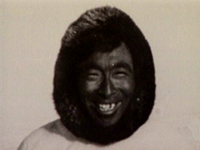 Language Keeper
Language Keeper
One of the monumental projects in the service of preserving Inuktitut was the compilation and publication in 1985 of an Inuktitut dictionary by Taamusi Qumaq, an elder from Puvirnituk. Taamusi passed away in 1995 but his works and accomplishments have been widely recognized and awarded. We pay tribute to his life and work using the many photos, recordings and texts that exist of Taamusi.
